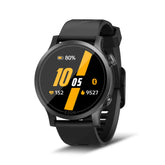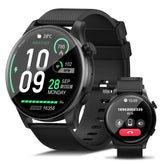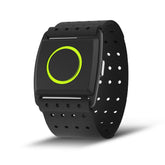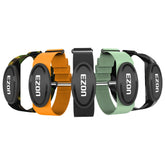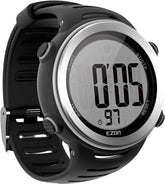Beginner’s Guide to Bouldering: Techniques, Gear, and Training Tips
Bouldering is a thrilling form of rock climbing that combines strength, agility, and problem-solving, all without the need for ropes or harnesses. Perfect for beginners, it’s a great way to build full-body fitness and mental resilience. In this guide, we’ll cover the basics of beginner bouldering, from essential climbing techniques to must-have gear like bouldering watch and chalk bags, plus training drills to boost the strength and agility needed to tackle your first bouldering routes.
What Is Bouldering?
Bouldering involves climbing short, challenging routes (called “problems”) on boulders or low walls, typically up to 15 feet high, with crash pads to cushion falls. It focuses on dynamic moves, balance, and precision, making it an accessible entry point to climbing for beginners.
Fundamental Climbing Techniques for Beginners
1. Grip Types
Mastering different grips is key to holding onto holds:
- Open Hand: Fingers curved, palm off the hold—ideal for large jugs.
- Crimp: Fingers bent at the first joint for small edges (start with gentle crimps to avoid injury).
- Pinch Grip: Squeezing a hold between your thumb and fingers, used for slopers or ledges.
2. Footwork Basics
- Edging: Pressing the edge of your shoe onto a small foothold—keep hips close to the wall for balance.
- Smearing: Using the rubber of your shoe to stick to featureless surfaces, common on slab walls.
- Weight Transfer: Shift body weight smoothly between hands and feet to maintain momentum.
3. Body Positioning
- Core Tension: Engage your core to keep your body stable and aligned with the wall.
- Dynamic Moves: Small, controlled jumps between holds—practice on low-angle routes first to build confidence.
Essential Bouldering Gear for Beginners
1. Climbing Shoes
- Fit: Snug but not painful—your toes should just touch the front of the shoe for precision.
- Types: Beginner-friendly shoes like the La Sportiva Tarantula (versatile for all holds) or Five Ten Anasazi (excellent for edging).
2. Chalk Bag and Chalk
- Chalk Bag: A waist-mounted bag filled with magnesium chalk to keep hands dry and improve grip. Look for one with a brush holder for cleaning holds.
3. Crash Pad
- Thickness: 4–6 inches for indoor bouldering, 6–8 inches for outdoor use to cushion falls from higher routes.
4. Bouldering Watch
- Durable Design: A rugged sports watch like EZON’s models, with scratch-resistant sapphire crystal and 5ATM water resistance, ideal for gym and outdoor use.
- Activity Tracking: Monitor climbing sessions by logging duration, attempts, and rest intervals—some models even track grip strength and finger endurance over time.
Training Drills to Improve Strength and Agility
1. Strength Training
- Pull-Ups and Deadhangs: Build upper-body and grip strength with weighted pull-ups (if advanced) or deadhangs (hold a hangboard for 10–30 seconds, 3–4 sets).
- Core Work: Plank variations, leg raises, and Russian twists to enhance body tension on the wall.
2. Agility and Balance Drills
- Slab Climbing: Practice on low-angle walls to improve footwork and balance without relying on powerful moves.
- Dynamic Reach Exercises: Target specific holds on a campus board (under supervision) to improve explosive power and precision.
3. Route Analysis
- Visualization: Study a bouldering problem from the ground first, planning each move and foot placement before climbing.
- Beta Testing: Try different sequences (called “beta”) to find the most efficient path—patience is key for problem-solving.
How to Train Safely as a Beginner
1. Warm-Up Properly
- Dynamic Stretching: Arm circles, leg swings, and hip openers to increase blood flow.
- Easy Routes: Climb 2–3 V0–V1 problems to warm up muscles and avoid strains.
2. Fall Safely
- Crash Pad Placement: Position pads directly below the route and slightly overlapping for multi-directional falls.
- Fall Technique: Tuck into a ball and roll to distribute impact—practice falling from low heights first.
3. Rest and Recovery
- Finger Care: Take 1–2 rest days between climbing sessions to prevent pulley injuries; use a grip strengthener for rehab.
- Track Progress: Use a bouldering watch to log weekly climbs and ensure you’re not overtraining—consistency beats intensity for beginners.
Choosing the Right Bouldering Gym or Spot
1. Indoor Gyms
- Look for gyms with beginner-friendly routes (rated V0–V3) and crash pads in good condition. Many offer classes on technique and safety.
2. Outdoor Bouldering
- Start at spots like Bishop, CA, or Fontainebleau, FR, known for moderate problems and soft landings. Always climb with a partner and research route ratings (V-scale) beforehand.
Embrace the Learning Curve
Bouldering is as much about mental toughness as physical strength. Expect to fall, retry problems, and celebrate small wins—every climb teaches you something new. Use a bouldering watch to track progress, set goals (e.g., “Complete 5 V2 routes this month”), and stay motivated.
Gear Up with EZON for Your Bouldering Journey
- Rugged Durability: Built to withstand accidental bumps on the wall or outdoor rocks.
- Activity Tracking: Log bouldering sessions, monitor rest intervals, and analyze grip performance over time.
- Style and Function: Sleek designs that transition from the gym to everyday wear, with long battery life for all-day adventures.
Start Your Bouldering Adventure Today
Bouldering is a sport that rewards persistence and curiosity. By mastering climbing techniques, investing in essential gear like a bouldering watch, and focusing on gradual agility training, you’ll build the skills and confidence to tackle more challenging routes.
Remember, every climber starts as a beginner. Lace up your shoes, chalk up, and let each problem be a step toward becoming a stronger, more agile boulderer. The wall is waiting—now go climb it!
